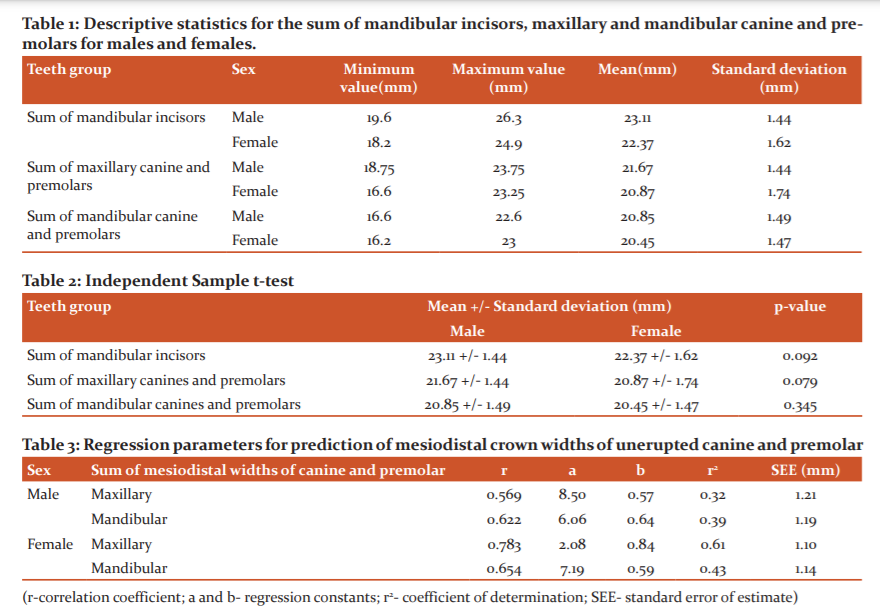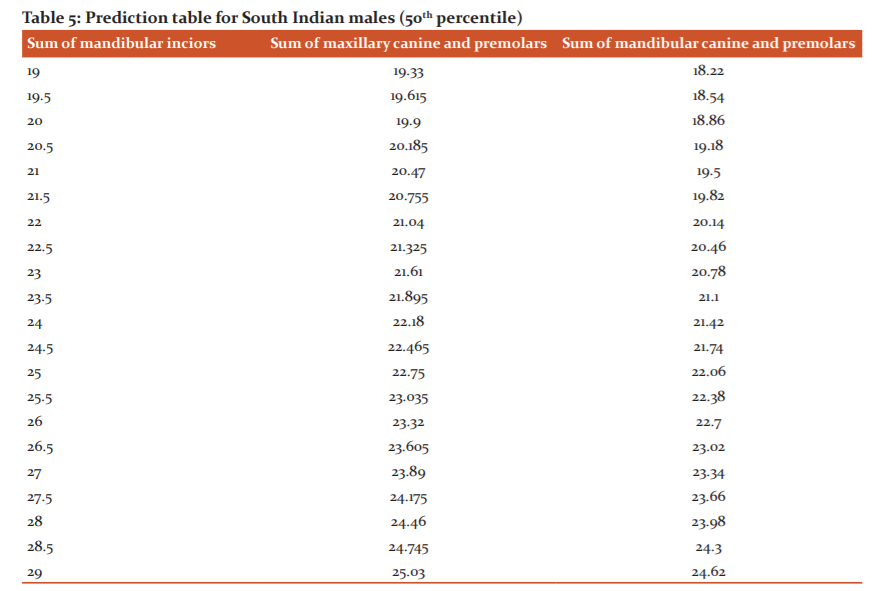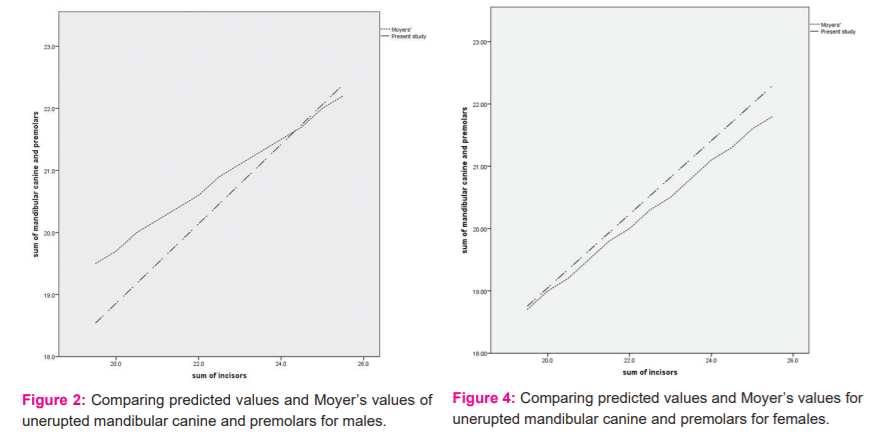IJCRR - 13(18), September, 2021
Pages: 01-07
Date of Publication: 26-Sep-2021
Print Article
Download XML Download PDF
Applicability of Moyers' Mixed Dentition Probability Tables and Development of New Prediction Equation in South Indian Population
Author: Murugesan Arathi, Subramanian Aravind Kumar
Category: Healthcare
Abstract:Introduction: Moyers' mixed dentition space analysis is the most commonly used analysis to detect the tooth size-arch length discrepancy in patients with mixed dentition. At the same time Moyers' method of prediction is said to have population variations. Aim: The present study aimed to evaluate the applicability of Moyers' mixed dentition probability tables in the South Indian population and to frame a new regression equation to predict the sum of mesiodistal tooth widths of the permanent canine and the premolars. Methods: Mesio-distal tooth measurements of teeth were measured using digital vernier calliper from the study models of 50 orthodontic patients. The tooth sizes were compared between males and females using statistical analysis. The new regression equation was formulated from the standard linear regression equation y=a+bx, where a and b are constants, x is the sum of the mesiodistal width of mandibular incisors and y is the sum of widths of canine and premolars. Results: • There was no significant difference between the tooth sizes of the males and females according to the data collected from the current study sample. • TMoyers' prediction tables are not suitable for predicting the mesiodistal widths of the unerupted canine and premolars in the South Indian population. Conclusion: New linear regression equations were formulated separately for males and females, to predict the sum of mesiodistal width of unerupted canine and premolars, using the sum of mandibular permanent incisors. The following are the new prediction equations: Males: Maxilla-8.50 + 0.57 (X) Mandible-6.06 + 0.64 (X) Females: Maxilla-2.08 + 0.84 (X) Mandible-7.25 + 0.59 (X), where X is the sum of the mesiodistal width of mandibular permanent incisors.
Keywords: Moyers probability tables, Mixed dentition space analysis, South Indian population, Prediction equation
Full Text:
INTRODUCTION
Tooth size- arch length discrepancy is one of the common reasons for malocclusion. In a growing child with mixed dentition, the developing malocclusion can be well assessed and managed by accurately predicting the tooth size of the unerupted teeth. This can help us analyse whether the available space is sufficient to allow the permanent teeth to erupt without causing any crowding.1
The mixed dentition space analysis (MDSA) helps in determining any tooth size- arch length discrepancy and also to decide the type of interceptive orthodontic treatment to be employed. This type of orthodontic treatment involves serial extractions, space regainers, space maintainers, guiding the path of eruption and also periodic observation of the patient.2
Three different types of prediction methods have been used.
(i) Radiographic method 3,4
(ii) Prediction equations and tables 5,6,7
(iii) Combination of both radiographic method and prediction tables 3,8,9
Of these methods, it is argued that Moyers’ method is more widely used.7,10,11 This MDSA is used to assess the mesiodistal width of unerupted canine and premolars using probability charts at the 75th percentile.12The Moyers’ probability tables were developed at the University of Michigan based on the data obtained from American white subjects of North-western European descent.5 Therefore it is not relevant to all races because it has been observed that tooth dimension differs among various ethnicities, races, and genders.9,12–18Thus the objectives of this study were to evaluate the applicability of Moyers’ mixed dentition probability tables in the South Indian population and to frame a new regression equation that would aid us in accurately predicting the summed width of the unerupted canine and premolars.
MATERIALS AND METHODS
The study models of 50 subjects (25 male, 25 female) of age group 13 to 25 years and South Indian origin, were obtained from the patient records in the Department of Orthodontics, Saveetha Dental College and Hospital, Chennai. The study design and methodology was approved by the Institutional Scientific Review Board (IHEC/SDC/ORTHO-1801/21/22).
The inclusion criteria for sample selection were the following:
-
All subjects were of South Indian origin.
-
The permanent mandibular incisors, maxillary and mandibular canines and premolars were all fully erupted.
-
The study casts were free of distortion.
-
The subjects had no previous history of orthodontic treatment.
The exclusion criteria were the following:
-
Tooth material loss due to interproximal caries, interproximal attrition, congenital defects, and fractures.
-
Presence of prosthesis.
-
Severe crowding of more than 8mm.
Mesio-distal tooth measurements of the mandibular central and lateral permanent incisors, the maxillary and mandibular permanent canines, and the maxillary and mandibular first and second premolars were measured. Measurements were made according to Moorrees et al.19 using a digital Vernier calliper, with an accuracy of 0.1mm. The calliper was held at the tooth’s greatest mesiodistal diameter (contact points), parallel to the occlusal surface and perpendicular to the tooth’s long axis.5,8,19
Statistical Analysis
Descriptive statistics, independent sample t-test and regression analyses were done using IBM SPSS software version 2.0.
RESULTS
Descriptive statistics, including the mean, standard deviation, and, minimum and maximum values for the sum of mandibular incisors, the sum of maxillary canine and premolars, and mandibular canine and premolars for males and females were calculated (Table 1).
Independent sample Student t-test was carried out to compare the mesiodistal crown widths of males and females for the 3 tooth groups. The statistical values showed no significant difference between the mesiodistal tooth widths of males and females with a p-value being greater than 0.05 (Table 2).
Regression parameters such as correlation coefficient, regression constants, coefficient of determination and standard error of estimate were calculated. Table 3 records the various regression parameters. Using these parameters, new standard linear regression equations of the form Y=a+b(X) were derived, to evaluate the relationship between the combined mesiodistal widths of the mandibular permanent incisors (X) and the mesiodistal widths of canine and premolars in maxilla and mandible. In the equation Y+a+b(X), a and b are the regression constants, where a is the y-intercept, and b is the slope of the regression line.
The new prediction equations to calculate mesiodistal crown widths of maxillary and mandibular unerupted canine and premolars using the sum of erupted mandibular permanent incisors for males and females are shown in Table 4. Tables 5 and 6 show the probability table for males and females at the 50th percentile.
Figures 1&2 and 3&4 graphically represent the comparison between Moyers’ prediction table and the new prediction tables at the 50th percentile levels for males and females in the maxilla and mandible respectively. The figures represent that the slopes of the two sets of data differ and the lines tend to cross each other. This implies that the predicted size of the maxillary canine and premolars for males is greater and mandibular canine and premolars for males is smaller than by the Moyers’ table. For females, the predicted size of maxillary canine and premolar is greater than Moyers’ value when the sum of the incisors is greater than 21.5mm. The predicted size of mandibular canine and premolars for females was also greater than that by Moyers’ table.
DISCUSSION
Moyers’ mixed dentition analysis is one of the most commonly used space analyses to predict the mesiodistal width of the unerupted canine and premolars. Moyers’ prediction tables were formulated based on the values obtained from the North American population.5,6,8 The tooth dimensions and craniofacial characteristics are said to differ among people of different racial and ethnic origins.2,7,9,13,15,19,20 Therefore, the present study was aimed to assess the reliability of the Moyers’ prediction table as well as to formulate a new prediction equation and table suitable for the South Indian population.
Multiple regression analyses have indicated that the sum of the mesiodistal width of the four mandibular permanent incisors is the best predictor for unerupted canines and premolars, as these are the teeth that are among the first to erupt during the early mixed dentition.21 considering this we have also used the sum of mandibular permanent incisors to predict the mesiodistal width of the unerupted canine and premolars in our study. The present study attempted to formulate a prediction table at the 50th percentile for the South Indian children since the literature was lacking in the formulation of prediction tables at different percentile values.
Table 7 shows prediction equations from various studies at the 50th percentile.
All the above-mentioned studies except the Tanaka Johnston study showed that the Moyers prediction tables either underestimated or overestimated the sizes of the unerupted canine and premolars for their respective study population. Tanaka and Johnston6 stated that the probability tables generated by them were practically similar to those of the Moyers’ at all percentile confidence levels, probably because of the similar North American white samples used in the two studies.
The importance of accurate prediction of the mesiodistal crown widths of unerupted canines and premolars during mixed dentition space analysis should be apparent, because the decision to treat, or not treat or the type of the treatment, is based on the results of the analysis. The space management protocol will be badly affected if it is based on a wrong estimation of the unerupted tooth sizes, ultimately resulting in poor treatment results. Developing new probability tables on the Moyers pattern, specifically for different population groups, can aid in achieving a more accurate estimation of the unerupted tooth sizes.22 The prediction table formulated based on the data from the Chennai population should be accurate when applied to the local children. Further investigation has to be done to evaluate the accuracy of the proposed prediction equation in the local population.
CONCLUSION
-
There was no significant difference between the tooth sizes of the males and females according to the data collected from the current study sample.
-
Moyers’ prediction tables are not suitable for predicting the mesiodistal widths of the unerupted canine and premolars in the South Indian population.
-
New linear regression equations were formulated separately for males and females, to predict the sum of mesiodistal width of unerupted canine and premolars, using the sum of mandibular permanent incisors. The following are the new prediction equations:
Males: Maxilla-8.50 + 0.57 (X)
Mandible-6.06 + 0.64 (X)
Females: Maxilla-2.08 + 0.84 (X)
Mandible-7.25 + 0.59 (X),
where X is the sum of mesiodistal widths of mandibular permanent incisors.
The accuracy of the prediction equation should be tested in a large sample of the local population and various other ethnic groups in South India.
ACKNOWLEDGEMENT
The authors acknowledge the immense help received from the scholars whose articles are cited and included in references of this manuscript. The authors are also grateful to authors/editors/publishers of all those articles, journals and books from where the literature for this article has been reviewed and discussed.
CONFLICT OF INTEREST
Nil
SOURCE OF FUNDING
Nil









References:
1. Kirschen RH, O’higgins EA, Lee RT. The Royal London Space Planning: an integration of space analysis and treatment planning: Part I: Assessing the space required to meet treatment objectives. Am J Orthod Dentofacial Orthop. 2000; 118(4): 448–55.
2. Bishara SE, Staley RN. Mixed-dentition mandibular arch length analysis: a step-by-step approach using the revised Hixon-Oldfather prediction method. Am J Orthod. 1984; 86(2): 130–5.
3. Staley RN, O’Gorman TW, Hoag JF, Shelly TH. Prediction of the widths of unerupted canines and premolars. J Am Dent Assoc. 1984; 108(2): 185–90.
4. de Paula S, de Oliveira Almeida MA, Lee PCF. Prediction of the mesiodistal diameter of unerupted lower canines and premolars using 45° cephalometric radiography. Am J Orthod Dentofacial Orthop. 1995; 107(3): 309–14.
5. Moyers RE. Analysis of the dentition and occlusion. Handbook of orthodontics. 1988.
6. Tanaka MM, Johnston LE. The prediction of the size of unerupted canines and premolars in a contemporary orthodontic population. J Am Dent Assoc. 1974; 88(4): 798–801.
7. Ferguson FS, Macko DJ, Sonnenberg EM, Shakun ML. The use of regression constants in estimating tooth size in a Negro population. Am J Orthod. 1978; 73(1): 68–72.
8. Hixon EH, Oldfather RE. Estimation Of The Sizes Of Unerupted Cuspid And Bicuspid Teeth. Angle Orthod. 1958; 28(4): 236–40.
9. Bishara SE, Jakobsen JR, Abdallah EM, Fernandez Garcia A. Comparisons of mesiodistal and buccolingual crown dimensions of the permanent teeth in three populations from Egypt, Mexico, and the United States. Am J Orthod Dentofacial Orthop. 1989; 96(5): 416–22.
10. Al-Khadra BH. Prediction of the size of unerupted canines and premolars in a Saudi Arab population. Am J Orthod Dentofacial Orthop. 1993; 104(4): 369–72.
11. Yuen KK, Tang EL, So LL. Mixed dentition analysis for Hong Kong Chinese. Angle Orthod. 1998; 68(1): 21–8.
12. Agarwal N, Shashikiran N D, Singla S, Kulkarni V K, Ravi K S.Moyer's Mixed Dentition Predictable Values Correlation Among Hindu Children of Bhopal City. Ann Essenc Dentis. 2013; 5: 6-10.
13. Jaroontham J, Godfrey K. Mixed dentition space analysis in a Thai population. Eur J Orthod. 2000; 22(2): 127–34.
14. Priya S, Munshi AK. Formulation of a prediction chart for mixed dentition analysis. J Indian Soc Pedod Prev Dent. 1996; 12(1): 7-11.
15. Lee-Chan S, Jacobson BN, Chwa KH, Jacobson RS. Mixed dentition analysis for Asian-Americans. Am J Orthod Dentofac Orthop. 1998; 113(3): 293–9.
16. Schirmer UR, Wiltshire WA. Orthodontic probability tables for black patients of African descent: mixed dentition analysis. Am J Orthod Dentofacial Orthop. 1997; 112(5): 545–51.
17. Diagne F, Diop-Ba K, Ngom PI, Mbow K. Mixed dentition analysis in a Senegalese population: elaboration of prediction tables. Am J Orthod Dentofacial Orthop. 2003; 124(2): 178–83.
18. de Carvalho Beckman CK, Costa Bezerra AA, Araujo PH, Araujo MA. Ethnic and gender aspects involved in craniofacial growth for the validation of Moyers and Tanaka-Johnhton analysis. Archives of Health Sci. 2020; 27: 42-6.
19. Moorrees CFA, Thomsen SØ, Jensen E, Yen PK-J. Mesiodistal Crown Diameters of the Deciduous and Permanent Teeth in Individuals. J Dent Res. 1957; 36(1): 39–47.
20. Uysal T, Sari Z. Intermaxillary tooth size discrepancy and mesiodistal crown dimensions for a Turkish population. Am J Orthod Dentofacial Orthop. 2005; 128(2): 226–30.
21. Gardner RB. A comparison of four methods of predicting arch length. Am J Orthod. 1979; 75(4): 387–98.
22. Philip NI, Prabhakar M, Arora D, Chopra S. Applicability of the Moyers mixed dentition probability tables and new prediction aids for a contemporary population in India. Am J Orthod Dentofacial Orthop. 2010; 138(3): 339–45.
23. Moyers RE. Development of the dentition and the occlusion. Handbook of orthodontics. 1973: 99-146.
24. Al-Kabab FA, Ghoname NA, Banabilh SM. Proposed regression equations for prediction of the size of unerupted permanent canines and premolars in Yemeni sample. J Orthod Sci. 2014; 3(3): 68.
25. Umapathy T, Praveen P, Ananthraj A, Ashwini CP. An evaluation of the validity of Moyer’s analysis and elaboration of prediction tables for Bangalore urban school children. Int J Ophthalmol Clin Res. 2014; 2(4): 39-48.
|






 This work is licensed under a Creative Commons Attribution-NonCommercial 4.0 International License
This work is licensed under a Creative Commons Attribution-NonCommercial 4.0 International License